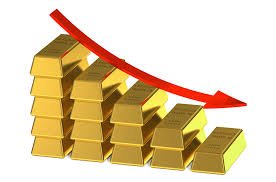Reasons of Gold Price Falling Today After US Fed Meeting
Gold, often regarded as a safe-haven asset, experiences fluctuations in its price influenced by various global economic factors.
Recently, the price of gold has seen a decline following the outcome of the US Federal Reserve (Fed) meeting.
Lets delve into the reasons behind this drop in gold prices, analyzing the Fed’s actions and their implications on the broader economic landscape.
The US Federal Reserve Meeting Outcome

The US Federal Reserve’s meetings are closely watched by investors worldwide, as they set the tone for monetary policy and economic outlook. In the latest meeting, the Fed made several key decisions:
- Interest Rate Decisions: The Fed decided to keep interest rates unchanged, which was widely anticipated. However, they signaled the possibility of future rate hikes if economic conditions warranted them.
- Economic Projections: The Fed provided updated economic projections, indicating a stronger economic outlook. They revised their GDP growth forecasts upward and suggested that inflation might remain elevated for a longer period than previously expected.
- Monetary Policy Stance: The Fed reiterated its commitment to its 2% inflation target and maximum employment. They also emphasized their readiness to adjust monetary policy as needed to achieve these goals.
Impact on Gold Prices

Several factors stemming from the Fed’s meeting outcome have contributed to the fall in gold prices:
- Stronger US Dollar: The prospect of future rate hikes and a stronger economic outlook have bolstered the US dollar. A stronger dollar makes gold more expensive for holders of other currencies, leading to reduced demand and lower prices.
- Rising Treasury Yields: The anticipation of tighter monetary policy and higher interest rates in the future has led to an increase in US Treasury yields. Higher yields make bonds more attractive relative to non-yielding assets like gold, prompting investors to shift their portfolios away from gold.
- Inflation Expectations: While gold is traditionally seen as a hedge against inflation, the Fed’s signaling of potential rate hikes to combat prolonged inflation has reassured investors. This reduces the need for gold as a safe-haven asset against inflationary pressures.
- Risk-On Sentiment: The Fed’s optimistic economic projections have boosted market confidence, leading to a “risk-on” sentiment among investors. This shift encourages investment in riskier assets such as equities, reducing the demand for safe-haven assets like gold.
Broader Economic Context
The recent developments need to be viewed within the broader economic context:
- Global Economic Recovery: As the global economy continues to recover from the impacts of the COVID-19 pandemic, riskier assets are becoming more attractive. This recovery, driven by vaccination campaigns and government stimulus measures, reduces the allure of gold.
- Central Bank Policies Worldwide: Other central banks, including the European Central Bank (ECB) and the Bank of England (BoE), are also signaling shifts in their monetary policies. These synchronized moves towards tightening monetary policy are influencing global asset prices, including gold.
- Geopolitical Stability: Relative geopolitical stability, compared to the uncertainty during the peak of the pandemic, has also reduced the demand for gold. Gold prices tend to spike during periods of heightened geopolitical risk.
Market Sentiment and Investor Behavior

Investor behavior and market sentiment play crucial roles in the dynamics of gold prices:
- Speculative Trading: Gold markets are also influenced by speculative trading. The anticipation of Fed policy changes can lead to increased speculative activity, resulting in short-term price volatility.
- ETF Flows: Gold Exchange-Traded Funds (ETFs) are popular instruments for gold investment. Changes in ETF flows, driven by investor sentiment and market outlook, can significantly impact gold prices. A shift away from gold ETFs towards other asset classes can amplify price declines.
- Physical Demand: Although less impactful in the short term compared to financial markets, physical demand for gold (jewelry, technology, central bank purchases) also plays a role. Changes in demand patterns, influenced by economic conditions and consumer behavior, contribute to price movements.
Conclusion
The fall in gold prices following the US Fed meeting outcome can be attributed to a combination of factors, including a stronger US dollar, rising Treasury yields, moderated inflation fears, and a shift in investor sentiment towards riskier assets.
The Fed’s optimistic economic projections and potential future rate hikes have reinforced these trends. Understanding these dynamics helps investors make informed decisions in a complex and interconnected global economy.
As always, monitoring central bank policies, economic indicators, and market sentiment remains crucial for anticipating future movements in gold prices.




